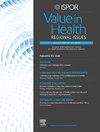使用临床乳房检查进行乳腺癌筛查:南非的成本-效果分析
IF 1.4
Q3 HEALTH CARE SCIENCES & SERVICES
引用次数: 0
摘要
目的世界卫生组织强调筛查和早期诊断,以降低晚期癌症的发病率和死亡率。在中低收入国家,由于发现较晚,乳腺癌生存率较低。南非的政策建议40至69岁无症状妇女每年进行两次临床乳房检查(CBEs)。我们评估了扩大CBE筛查对死亡率和成本效益的影响。方法利用降分期试验数据,我们将当前基线(5%覆盖率)与方案1(5年覆盖率25%[即每年增加5%])和方案2(5年覆盖率75%,[即每年增加17.5%])进行比较。一个队列模型跟踪了从筛查到诊断的妇女,估计了降低分期对BC病例的影响。从医疗保健支付者的角度来看,成本以2022年美元表示。结果5年筛查检出率分别为2.39 / 1000和2.08 / 1000筛查情景1和2。方案1将BC死亡率降低0.7%,方案2降低2.3%。与没有筛查相比,目前的基线筛查计划以20341美元/例避免了1645例残疾调整生命年(DALY)。方案1避免了3823个DALYs,经济效率提高到17776美元/ DALYs,而方案2避免了12165个DALYs,避免了19552美元/ DALYs。结论scbe的扩大有效地节省了生命年,但在国家机会成本衍生的阈值3015美元/避免的DALY下并不具有成本效益。然而,关于最佳筛查政策的决定并不仅仅基于成本效益。它们涉及仔细考虑预算限制和相互竞争的医疗保健优先事项。扩大规模应考虑系统容量、最低护理标准和具有成本效益的早期发现战略。本文章由计算机程序翻译,如有差异,请以英文原文为准。
Breast Cancer Screening Using Clinical Breast Examination: A Cost-Effectiveness Analysis for South Africa
Objectives
The World Health Organization emphasizes screening and early diagnosis to reduce advanced cancer incidence and mortality. In low-to-middle-income countries, breast cancer (BC) survival rates are low because of late detection. South Africa’s policy recommends twice-yearly clinical breast examinations (CBEs) for asymptomatic women aged 40 to 69. We assessed the impact of scaling up CBE screening on mortality and cost-effectiveness.
Methods
Using trial data on downstaging, we compared the current baseline (5% coverage) with scenario 1 (25% coverage by year 5 [ie, 5% increase annually]) and scenario 2 (75% coverage by year 5, [ie, 17.5% increase annually]). A cohort model tracked women from screening to diagnosis, estimating downstaging’s impact on BC cases over their lifetime. Costs from the healthcare payer’s perspective are presented in 2022 US dollars.
Results
Five-year screen detection rates were 2.39 and 2.08 per 1000 women screened for scenarios 1 and 2, respectively. Scenario 1 reduced BC mortality by 0.7% and scenario 2 by 2.3%. Compared with no screening, the current baseline screening program averts 1645 disability-adjusted life years (DALYs) at $20 341/DALY averted. Scenario 1 averted 3823 DALYs with economic efficiency improving to $17 776/DALY averted, whereas scenario 2 averted 12 165 DALYs at $19 552/DALY averted.
Conclusions
CBE scale-up effectively saves life years but is not cost-effective under the country’s opportunity cost-derived threshold of $3015/DALY averted. However, decisions on the best screening policy are not solely based on cost-effectiveness. They involve careful consideration of budgetary constraints and competing healthcare priorities. Scale-up should consider system capacity, minimum care standards and cost-effective early detection strategies.
求助全文
通过发布文献求助,成功后即可免费获取论文全文。
去求助
来源期刊

Value in health regional issues
Pharmacology, Toxicology and Pharmaceutics-Pharmacology, Toxicology and Pharmaceutics (miscellaneous)
CiteScore
2.60
自引率
5.00%
发文量
127
 求助内容:
求助内容: 应助结果提醒方式:
应助结果提醒方式:


